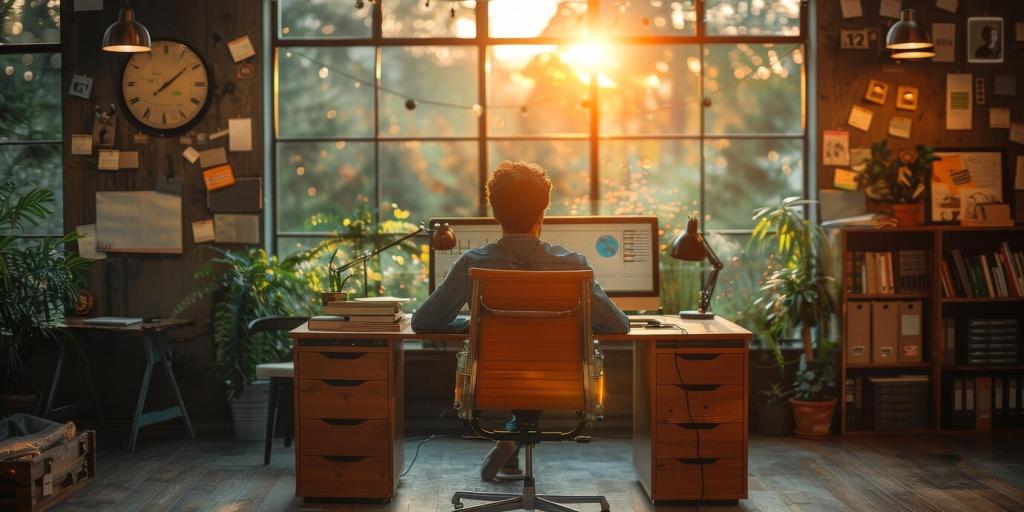
Creating a Distraction-Free Home Workspace
Selected theme: Creating a Distraction-Free Home Workspace. Transform any corner into a calm, high-focus studio with practical design moves, science-backed tweaks, and cozy rituals. Share photos of your setup, ask questions, and subscribe for weekly focus-friendly prompts.
Map Your Focus Zone
Aim your desk toward a plain wall or a window at a side angle so movement is outside your main field of view. One reader rotated their desk ninety degrees and immediately sat longer, reporting fewer urge-to-check moments. Try it and comment.
Map Your Focus Zone
Use a small rug, a task lamp pool of light, or a narrow shelving unit to outline a dedicated focus zone. When you step in, work begins; when you step out, you are off. Sketch your room and share your zoning draft.


Silence the Noise, Keep the Energy
Cognitive work improves when background noise stays near library levels. Add door seals, a draft stopper, a dense rug, or heavy curtains to tame echoes. Measure with a free phone meter for a week and share your average reading for comparison.

Light That Supports Deep Work
Place the desk perpendicular to a window, not facing or backing it. Sheer curtains diffuse harsh beams, and a matte screen reduces reflections. Notice where sunlight lands at 3 p.m. this week and adjust position one foot to the calmer side.
Aim for a focused task lamp around neutral-warm 3500–4500 K with a dimmer, plus soft ambient fill so your screen is not the brightest thing. Bounce light off a wall rather than eyes. Comment with your favorite under-100-dollar desk lamp.
As sunset approaches, lower brightness and shift warmer to protect sleep. Use screen warmers and a secondary, non-glowing notepad for late ideas. Many readers fall asleep faster after reducing blue light post 8 p.m. Try it for a week and share.
One surface rule
Choose one clear work surface with only today’s active materials, a lamp, and water. Everything else waits elsewhere. End every session with a sixty-second reset. People say this tiny ritual saves tomorrow’s momentum. Try it tonight and report back.
Closed storage, labeled kindly
Use boxes or drawers with simple, friendly labels so every object has a home. Closed fronts quiet the eyes and reduce rummaging. A cedar block or linen liner adds a subtle cue of order. Share your label wording that actually sticks.
Color palette that recedes
Limit the workspace to two or three calming colors and one plant or wood accent for warmth. Research suggests natural elements help attention recover. Hide bright packaging in opaque containers. Post your palette swatches or the plant that makes you breathe easier.
Reset notifications from zero
Turn everything off, then add back only truly critical alerts. Batch checks at preset times, use VIP for emergencies, and schedule Do Not Disturb during deep work. Screenshot your notification settings and inspire someone else to reclaim their focus.
Single-tab, single-intent
Work in one window with one goal. Go full screen, auto-hide the dock, and close loops with a short end-of-task note predicting your next step. Try it for forty-eight hours and tell us how your mental friction changed.
Friction for tempting apps
Add blockers, grayscale your phone, and park it in another room during sprints. Keep a tiny log of urges to check and what triggered them. A developer saved two hours daily doing this. Share your best anti-urge phrase or prompt.
Startup ritual in three breaths
Sit, plant your feet, take three slow breaths, state the intention aloud, and start a ten-minute warm-up task. One designer rebuilt confidence after burnout with this tiny sequence. Try Monday morning and reply with the sentence you choose.
Micro-resets that prevent spirals
When you drift, label it, stand, stretch, sip water, and re-enter with a single next action. Use a soft chime, not a harsh alarm. Celebrate recoveries, not perfection. Share your favorite micro-reset and how many minutes it returned today.
Shutdown that lets you leave
Write tomorrow’s first step, tidy the desk, close apps, and cover the laptop or monitor. A short phrase like “Work is parked” signals completion. Readers sleep easier with this boundary. Subscribe to get a one-page shutdown checklist to print.
Join our mailing list
